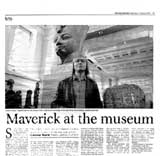| |
|
 |
 |
 |
 |
 |
|
Maverick at the
Museum
He doesn't look like a museum curator and he doesn't think like one either.
Louisa Buck meets James Putnam
by Louisa Buck, London Evening Standard, August 13, 2001.
"Sometimes I see myself as a kind of matchmaker", says James Putnam,
"introducing the museum and all its additional virtues to the world of contemporary culture. It’s
basically about bringing together the cultures of the past and the present, and making something new".
With his blue jeans, leather jacket and floppy blonde pageboy, Putnam looks more like Brian Jones’
long-lost brother than a British Museum curator, and his often unorthodox combinations of ancient and modern
have been making some waves within the rarefied ranks of Britain’s museum Establishment,
"I get sad when people say that museums are dusty old places which have nothing to do with the present",
he says. "I want to tap into the energy of the museum and the energy of the new things that are being created all around us".
Recently there has been a flurry two-way traffic between contemporary art and the museum –the Serpentine and the V&A
did an exchange earlier in the year and the Science Museum has a contemporary art programme – but what singles out
James Putnam’s museological matchmaking is the way in which, as he puts it, "the museum becomes a working medium
for artists".
He first made his mark back in 1994 when, as a junior curator in the BM’s Egyptian Antiquities Department,
he organized Time Machine, an ambitious exhibition, which invited contemporary artists to respond to and show
their work among the ancient artifacts in the BM’s Egyptian Galleries. These ranged from a 30-ton temporary
sand sculpture by Andy Goldsworthy to Stephen Cox’s bowls carved from Egyptian porphyry and Marc Quinn’s
transparent head containing a hibernating frozen frog displayed among the Gods of Resurrection –"it was very
brave of the museum to have gone for it".
We put sculptures in the sarcophagi and even a sound piece in one of the stone shrines. But they only agreed
to the Goldsworthy Sandwork if it could be cleared up after two days". Putnam recalls.
Since then, Putnam projects have included Richard Wentworth trawling the British Museum’s rubbish bins
for drinking utensils, which he then meticulously labeled and displayed alongside the BM’s collection of
Egyptian vessels; Terry Smith chiselling the image of a giant column head into the wall of the Roman Britain Galleries,
or the recent sell-out Evening with Tracey Emin which, although billed to coincide with the BM’s Cleopatra exhibition,
ended up being less about the Queen of the Nile, and more about the Queen of Hoxton’s holiday in Egypt.
Putnam’s official title is Curator of the Contemporary Arts and Culture Programme at the BM, but he’s
eager to stress that he is not interested in commissioning art or making an alternative Tate Gallery in the British Museum.
"With our work we don’t necessarily have to produce anything. It can be purely research and development".
It also doesn’t have to be restricted to art. Right now, for example, dancer Michael Clark is halfway through
a Putnam-instigated residency at the BM. "He’s been going round the galleries looking at the sculpture
–he’s particularly interested in the gesture of the hands on Greek and Buddhist sculpture. Later we’ll
hopefully raise the funds for him to do a performance here, or maybe make a video piece".
Other plans include a project with designer and Habitat supremo Tom Dixon and a proposed evening with Gilbert and George.
Putnam’s activities also expand way beyond the hallowed portals of the British Museum. Over at the Freud Museum
in Hampstead last year, working as a freelance curator, he put on one of Sarah Lucas’s most memorable exhibitions,
Beyond the Pleasure Principle, which included the dressing up of Freud’s dining room chairs in male and female
underwear and coitally uniting them with the help of a suggestively placed
fluorescent lighting strip.
Other interventions are more low key. Currently on show at the Petrie Museum, a treasure trove of everyday Egyptian
artifacts tucked away inside London’s University College, is an installation by Putnam from the Museum of Jurassic
Technology, a Los-Angeles based hybrid of museum and artwork founded and run by artist film-maker David Wilson.
Set among the glass cases of shards, beads, fragments of clothing and the occasional mummified head, Wilson has installed
two antique-looking view-finders which provide an audio-visual account of Sir William Flinders Petrie, archaeological
pioneer and the excavator and collector of all the surrounding exhibits, and his mentor, Royal Astronomer Charles Piazzi
Smith. Peering through the eyepieces of these specially customized ‘orthoraiders’ the viewer is treated to a
quirky combination of vintage stereoscopic photographs and a mellifluous voice-over, delivered by a female American narrator,
which outlines the mind-boggling quest by these Eminent Victorians to fathom what they considered to be the divine geometry
of the Great Pyramid.
"It’s about curiosity and personal obsessions – they are what really underpin all museums and their collections",
says Putnam, who is delighted to report that the Petrie Museum is so happy with his intervention that it has decided to
make it a permanent part of its display.
|
 |
| |
 |
 |
|
|